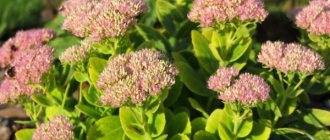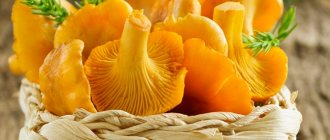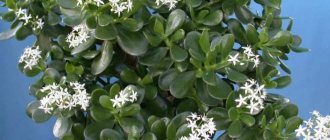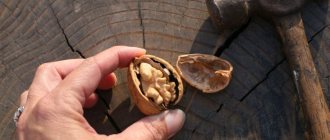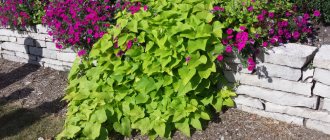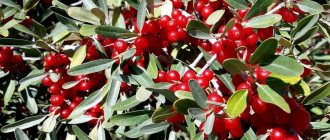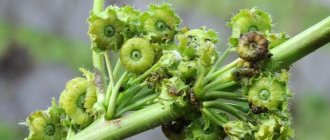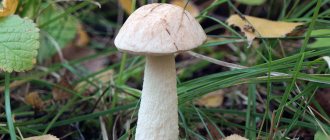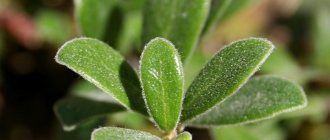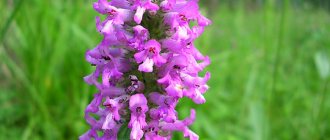Characteristics of the plant Potentilla gossamer
Potentilla is a beautiful decorative flower.
used in traditional medicine recipes. Let's talk about the healing properties of the plant and its use. The Latin name for “crow's foot” is Potentilla anserina L. A perennial plant belonging to the Rosaceae family, it is distinguished by a thick and short rhizome and creeping “whiskers”, the shoots of which can reach a length of up to 70 centimeters.
This grass is ubiquitous in temperate latitudes of the northern hemisphere (in European and post-Soviet space), with the exception of high mountain regions. It chooses moist soil and bright light, and takes root intensively near ponds, in homes and in places where livestock graze.
The plant stabilizes the meadows with a luxurious carpet and is easily recognized by its elongated and smooth green leaves, characterized by hairs.
During flowering from May to August, the plant looks incredibly attractive thanks to the tall and pleasantly smelling yellowish-golden flowers that grow from the axils of the leaves.
The flower of the honey plant consists of five petals, and the fruits of the cinquefoil are clusters of dry seeds. Thanks to its beauty, the plant has found application in landscape design; in particular, it is widely used in the design of alpine slides.
What to remember
Traditional treatment will achieve positive results in one case - with the correct use of homemade herbal medicines. This is not difficult to do - by strictly following some rules that should be remembered even before the course:
- prepare herbal decoctions, infusions from high-quality raw materials (collected in clean regions or purchased at a pharmacy);
- adhere to the requirements set out in the recipe - the amount of the main component should not exceed the dosage;
- consume at a strictly prescribed time, if a complex effect on the disease is being carried out, observe the intervals between doses;
- Before using even slightly saturated formulations, consult a doctor - self-medication can lead to dangerous consequences.
It is also recommended that the first doses be carried out carefully, carefully observing the body’s reaction to the active component of home remedies. Unpleasant discomfort, deterioration in the general condition of the body - a signal to immediately stop continuing the course
Cinquefoil is a herb that grows everywhere, so collecting medicinal raw materials will not be difficult; you can independently stock up on a valuable component of home medicines throughout the summer.
Using the plant in the treatment of diseases will bring considerable benefits, even if drug therapy is prescribed - herbal medicines will effectively increase the effect of pharmaceutical drugs.
(1 rating, average 5 out of 5)
What does a crow's foot look like?
Crow's foot, as people also call it, is a perennial herbaceous plant belonging to the Rosaceae family. In addition, it is worth taking into account the fact that other names for the culture are known, for example:
- convulsive grass;
- Martin's hand;
- toad picker;
- Dubrovka goose.
If we look at the appearance of the goosefoot, it is worth noting that it has a rather thick and multi-headed rhizome with creeping root stems, the length of which can reach 70 cm. In some places, thin tendrils can extend from the stem, which in turn grow into the ground.
The leaves are basal, periodically pinnate, and may contain from 9 to 20 pieces. The leaf blade has a green tint on top, the bottom has a silver-white felt, velvety to the touch.
The leaves of the stem located in the lower part of the plant are short-leaved, in the upper part they are reduced, with a small number of them. The shoots, as a rule, emerge from the axils of the leaves, on which the flowers, consisting of 5 petals, are located individually.
During the flowering period, flowers of a rich golden-yellow hue appear on the crop, the cup is double, it contains pistils and stamens. A distinctive feature is the rather pleasant smell that the plants emit. The flowering period lasts from May to the end of August.
Attention! Many people tend to believe that goose grass is akin to galangal.
Collection and procurement of raw materials
Since goosefoot has beneficial properties and is actively used in medicine, many people collect plants for further storage and use. As a rule of thumb, you can use all parts of the crop, including grass, flowers and seeds.
It is recommended to start harvesting at the moment when the flowering period begins, that is, from the beginning of May to the end of August. In order to dry the collected grass, you must use a special dryer; in addition, the place must be dark and well ventilated.
You can start collecting seeds after the fruits are fully ripened, namely in the second half of August. The root system can be dug up in early spring or autumn only after the above-ground part has dried. If the dried herb is stored properly, the healing properties can last for several years.
It is important to note! It is recommended to collect grass as far from the highway as possible.
Potentilla goose - medicinal properties
The plant has anticonvulsant, analgesic, diuretic, astringent, hemostatic and wound-healing effects, regulates metabolism in the body.
Since ancient times, the astringent properties of cinquefoil have contributed to its use as a remedy for diarrhea, bleeding, profuse mucous discharge, as well as for rinsing the mouth with a decoction for bleeding gums and cracked tongue. The rhizome is particularly effective as an astringent.
Experiments on animals showed the muscle-contractile and antispasmodic effects of herbal preparations, and then choleretic activity, the ability to reduce blood cholesterol and anti-inflammatory properties.
The extract of this plant is included in many medicines. Tea made from bloodroot itself and its mixtures with other medicinal plants also has an effective effect.
Indications for use
Due to its unique natural composition and many healing properties for the body, cinquefoil is used in various fields of traditional medicine. Most often, products based on a valuable plant are used to eliminate the following pathological conditions:
- Oral diseases: stomatitis, bleeding gums, gingivitis.
- Pathologies of the respiratory system: tonsillitis, bronchitis, pharyngitis, cough of unknown etiology.
- Disorders of the blood vessels and heart: atherosclerosis, myocardial weakness, persistent hypotension.
- Neurological disorders: epilepsy, sciatica, muscle pain.
- Musculoskeletal system disease: arthritis, osteochondrosis, arthrosis.
- Digestive diseases: disruption of the digestive process, decreased secretion of digestive enzymes, ulceration of the mucous membrane of the stomach and intestines, inflammatory diseases of the liver and gallbladder, frequent loose stools, intestinal dysbiosis, hemorrhoids.
- Pathologies of the female and male urinary system: cystitis, nephritis, urolithiasis.
- Disorders of the reproductive system: inflammatory diseases of the uterus and appendages, painful and heavy menstruation, prostatitis. Central nervous system disorders: frequent stressful situations,
- depressive states, disturbance of psycho-emotional balance, insomnia, deterioration of memory and concentration.
- Food and other types of body poisoning.
- Dermatological diseases: long-term non-healing wounds, cuts, cracks, eczema, dermatitis, furunculosis.
- Failures in the process of hematopoiesis, characterized by a decrease in the number of blood clotting factors.
- Metabolic disorders: diabetes, obesity.
- The healing properties of goose foot herb are successfully used to strengthen the immune system, prevent frequent colds and viral diseases, increase body tone, stimulate vitality and physical endurance.
- Some works of ancient healers describe the plant’s ability to cope with infectious diseases.
Contraindications for treatment
Despite all the benefits of cramp herb, its use is not always safe.
In some cases, products based on it cause harm to the body. Treatment with cinquefoil for persistent arterial hypertension is strictly prohibited, since there is a high risk of developing a hypertensive crisis. Individual intolerance will also become an obstacle to treatment with valuable herbs. It is not recommended to use the product for medicinal purposes in patients with a tendency to thrombosis or varicose veins. The drug is contraindicated for diagnosed severe colitis and persistent constipation.
Children under 7 years of age are not recommended to take herbal remedies. During pregnancy and breastfeeding, you should consult a specialist about the advisability of using the plant.
Excessive and uncontrolled use of cinquefoil provokes unpleasant consequences in the form of a rash, hyperemia and itching of the skin, headaches, and indigestion.
How to use
The medicinal properties of cinquefoil leaves can be supplemented by the dried root, which also has medicinal properties.
For tuberculosis
Pour 20 g of herb into 200 ml of water. Cook over low heat for a quarter of an hour and strain after two hours. Take three times a day before meals.
Colic
Pour a teaspoon of chopped herb into a glass of boiling water and leave for half an hour. Take a hot drink, dividing the indicated amount into 3 parts, three doses before meals. The course of treatment is 7 days.
For diarrhea
Pour 10 g of crushed rhizome with 250 ml of boiling water. Cook over low heat for a quarter of an hour. Let it brew for twenty minutes, then strain. Take four tablespoons four times a day.
From scurvy
Pour 20 g of herb and plant rhizomes into a liter of boiling water (they should be taken equally), leave for an hour. Strain and drink a glass three times a day for at least 10 days. The same decoction can be used for diarrhea and bleeding, but use it as needed and in a shorter time.
Anti-obesity
Mix the following herbs in equal parts:
- mint,
- thrush,
- shepherd's purse,
- goosefoot,
- nettle,
- wheat grass.
Boil 20 g of the collection in a water bath in 300 ml of water for about 15 minutes. Leave for another half hour, dilute with hot water (50 ml). Take 2 tablespoons three times a day for obesity for 21 days. This remedy helps improve metabolic processes and lose weight; it is also used for gout and polyarthritis.
For cholelithiasis
Collect fresh cinquefoil and green rye herbs. Take the plant in equal quantities, wash it, rinse with boiling water. Squeeze the juice from the plants, first grind with a blender. Take a tablespoon diluted with water twice a day for a week.
For painful menstruation
Brew a tablespoon of herb with a glass of boiling water and leave for an hour. Soak gauze in the infusion, apply to the pubic areas in a warm form. Keep it there until the pain subsides.
Against allergies
Mix a teaspoon of crow's feet, ground bay leaves, calendula flowers, dried string. Brew the mixture with half a liter of boiling water. Leave overnight, then strain. Add 2 teaspoons of natural apple cider vinegar to the infusion. Drink 50 ml three times a day after meals. The course lasts 10 days.
With high blood pressure
Pour 30 g of young stems, roots and flowers of cinquefoil into a glass of boiling water. After eight hours, filter. Take two-thirds of a glass three times a day before breakfast, lunch and dinner.
If hypertension is still in its infancy, another decoction should be prepared to help stabilize the blood pressure. Pour 10 g of chopped leaves and stems of herbs into 200 ml of boiling water. After eight hours, strain and take 100 ml half an hour before breakfast and before lunch.
From purulent wounds
Extract juice from fresh cinquefoil plant. First you need to wash it thoroughly. Mix a tablespoon of juice with 60 g of rendered pork fat. Stir the mixture, put it in a dark place, then melt it again. Add a teaspoon of wax to the hot ointment, and propolis on the tip of a knife.
Boil the ointment in a water bath for 5 minutes, put it in the refrigerator for a day. Apply the ointment to the wound under a bandage every day. The wound will soon be cleaned and healed.
For hemorrhoids
Infuse 20 g of cinquefoil herb in a glass of water for 2 hours. Strain and moisten a small gauze pad. Insert the resulting tampon into the rectum and lie down. Leave the product for 20 minutes, then remove. Carry out 7-10 such procedures, and do therapeutic sessions in the evening.
Tea against prostatitis
In case of prostate pathology, treatment can be carried out using oubrovica anserina. The action of microelements contained in the medicinal plant will help relieve inflammation and reduce the symptoms of the disease.
Taking cinquefoil for prostatitis optimizes the functioning of the gland, removes harmful substances from the body and strengthens the general condition of the internal organs.
Ingredients:
- Dried cinquefoil leaves - 2 tsp.
- Water - 250 ml.
How to prepare: pour the required amount of herb with boiled water. Infuse the mixture for 10-15 minutes, strain.
How to use: Drink tea in small sips. Don't add sugar.
Result: reduction of pain and discomfort, improvement of general condition.
To add flavor to the tea and increase its benefits, you can add a decoction of mint and lemon balm, taken in equal quantities.
Decoction against prostatitis
For prostatitis, you can prepare a decoction based on cinquefoil.
Ingredients:
- Dried goosefoot leaves - 10 g.
- Milk - 200 ml.
How to prepare: pour cold milk over the medicinal herbs. Bring the mixture to a boil and cook for about 5 minutes. Strain and let cool.
How to take: take half a glass of the prepared decoction twice a day.
Result: anti-inflammatory and restorative effect on the prostate gland.
Tincture for prostatitis
You can take a more concentrated water tincture.
Ingredients:
- Dried cinquefoil root - 3 tablespoons
- Water - 1 l.
How to prepare: bring water to a boil and add chopped root. Leave for an hour, then strain.
How to use: drink 1 glass of medicine half an hour before meals three times a day.
Result: reduction of pain, restoration of normal functioning of the prostate gland.
Use in cooking
It is noteworthy that cinquefoil is used not only in medicine, but also in cooking. Fresh leaves and shoots are added to salads and soups. When dried, crushed leaves and roots are used as a seasoning for meat and fish dishes due to their tart taste. Cinquefoil is present in many dishes of national English cuisine.
In addition, flour is prepared from the roots of goose grass. They are first soaked for several days to remove the bitterness characteristic of this plant, and then dried and crushed. The finished powder is mixed with rye flour and used for baking bread. Potentilla roots are also consumed fried as an independent dish.
Cooking green cabbage soup from cinquefoil
You will need the following ingredients: one kilogram of a mixture of different greens: sorrel, nettle, cinquefoil, spinach, wild garlic, parsley, green onions, etc. in any proportions. For the broth: 1 kg of veal brisket, one carrot, one onion, bay leaf. For dressing: six potatoes, one carrot, three hard-boiled eggs, mustard, horseradish, mayonnaise and sour cream.
Rinse the meat, place in a saucepan and cover with cold water. Bring to a boil, skim off the foam. Reduce heat, add salt, bay leaf, carrots and onion. Boil for one and a half hours.
Pour cold water over the greens and let stand for twenty minutes. After this, rinse thoroughly, dry and cut. If you use nettle, be sure to scald it with boiling water first.
Peel the potatoes and carrots and cut them into cubes. Cut the eggs in half lengthwise, remove the yolks and grind with mayonnaise, horseradish and mustard, then stuff the whites with this mixture.
Remove meat and seasonings from broth. Strain the broth, put on the fire and bring to a boil, then add the vegetables
Please note that they should be thrown into the pan at five-minute intervals in the following sequence: first potatoes, then carrots, then nettles. After a quarter of an hour, add the rest of the greens, and after five minutes, remove the pan from the heat
Sprinkle the cabbage soup with parsley or green onions and add sour cream. Stuffed eggs are placed on a plate with cabbage soup before serving.
